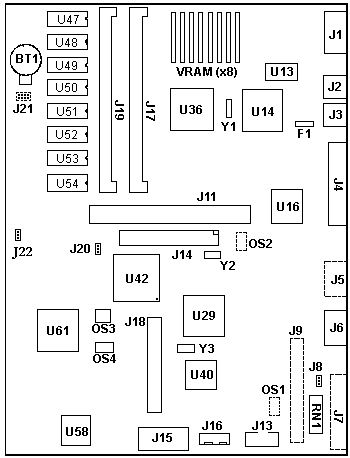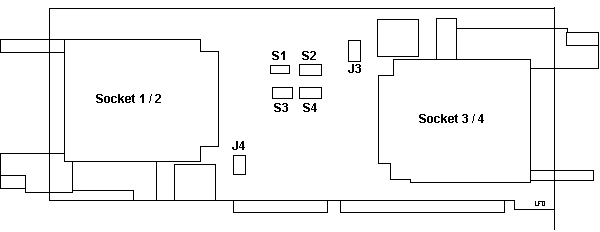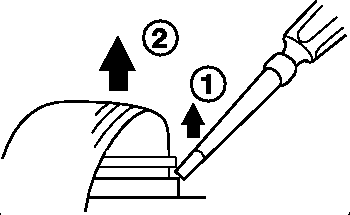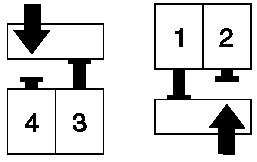|
193-226 IBM PS/2 E (9533) Models Without a Monitor or Display 193-347 IBM PS/2 E (9533-GBD and DBD) and 340MB Hard Drive Option ps2estrt.exe 9533E Starter Diskette
v1.0
9507 Color Display (LCD) 9533 Planar
9533 Planar Note: Some Model 35 and Model 40 computers use this system board. 
J22 Flash Memory Select Jumper
Adjustable Floor Stand Accessory (P/N 91F1028)
PS/2 E (Model 9533) FAQ Don Hills posted the original PS/2 E (Model 9533) FAQ on CompuServe. His work provided the base for my adventures with the "Big e". The PS/2 E (model 9533) system unit has a PS/2 model 35 motherboard.
486SLC2 25/50 MHZ CPU, 4 MB memory soldered in, 2 sockets for IBM PS/2
style SIMMs (2, 4 or 8 MB), to a maximum of 16 MB of total system memory.
IDE controller, but only enough room inside for a laptop 2.5 inch IDE drive.
XGA-2 video w/1MB of VRAM on motherboard. One ISA bus slot, depending
on the model it may contain:
486SLC2 Characteristics From Peter See: the 486SLC2 processor in the 33 is *technically* a souped-up 386SX. It is an interesting mix of technologies. - external bus is from the 80286: 16 data and 24 address lines - internal 16K Level-1 cache is inherited from the 386SLC - 32-bit processor core is compatible with a 486SX (no integrated FPU) - power-management comes from the 386SL laptop processor - pin-out and case (PLCC) comes from the 386SX - additional MathCo is a 387SX-25 - internal clock-doubling is taken from the 486DX2 line 16MB RAM Limit
MEMORY:
387 Math Coprocessor
HARD DISK DRIVES: It'll accept any 2.5 inch IDE laptop drive, provided it is not too "high" (thick), as it has to fit under the diskette drive. I think the drives come in 2 common heights- 12 mm and 17 mm- and the space available is only about 15 mm high. Disk Manager for
>528MB
HD Cable 39G6566
has the right power tap-off. Laptop IDE drives have the power wires on
the same plug as the signal cable, but the 9533 is "desktop" IDE where
the power is separate. The IBM cable splits out the power wires to
a special connector from the power supply. The stock
IBM drives can be found here IBM
H2172-A2 (172MB), H2258-A3 (258MB) & H2344-A4 (344MB)
Floppy Drive The BIOS DOES have support for the 2.88MB floppy. IBM Thinkpad 720 diskette drive. The 1.44MB floppy is a Teac FD-05HG-263-U or IBM Part 1619640. Floppy Tape Connector
Floppy Tape
Removal
Reseating Floppy
Tape
Note: I had a strange problem with
my floppy. Tried reseating the tape, no go. I was turning it over, looking
for model numbers, when I heard something rattle. Turns out somebody had
stuck a safety pin in the floppy. So if small children have been in the
area, just remember they like to stick small objects in anything with a
door. VCRs. Tape decks, Sewing Machines. Computers....
BUS: The machine has a single ISA slot. Power Restrictions From Don Hills I installed a Sound Blaster 16-SCSI adapter. The CDROM drive cable ran out of the back of the case to the drive, which I put in an external box with its own power supply. It sits on top of the PS/2 E. Note that the internal power supply in the PS/2 E is 24 Watts. I had to disable the internal speaker amplifiers on the sound card, it was hanging the machine when loud sounds were played. I now use external amplified speakers. Most recent sound cards no longer have internal amplifiers anyway- people prefer external amplifiers to get more power, and control over volume/bass/treble etc. DISPLAY ADAPTER: The planar video is XGA-2, for DOS/Windows you will need the XGA device driver diskette (latest version is V2.12.) XGA-2 Patch
>Yes - but the XGA-2 driver with Winblowz is for the MCA-version only. The 9533 has ISA XGA-2 and it seems it does not work very well together. I'd managed toget it going under Win95 IIRC ... I deleted the Wincrap from it and installed Linux ... From Don Hills (looks to be a long thread)
As for hard disk noise, the APM for DOS and OS/2 works fine. VESA POWER MANAGEMENT
At step 4, power consumption is reduced below 8 watts. DIAGNOSTIC AND SETUP DISKETTES: It is an ISA bus system and, in common with IBM's other PS/2 ISA bus systems, does not have a Reference diskette. It does have a "Starter" diskette, and a "Utility" diskette which contains, amongst other things, management utilities and drivers for the 4-slot PCMCIA adapter that some models shipped with. 4 Slot PCMCIA Adapter 
Switch Positions
on PCMCIA Adapter
From Daniel Basterfield
PCMCIA Drivers
for DOS/Win3.1x
utte131.exe PCMCIA Device Drivers for 9533
Using ISA2SLOT
Win95 PCMCIA Support
Testing the PCMCIA Adapter The PCMCIA adapter acts as a bus from the planar to the option adapters. If the computer has a problem, carefully remove and reseat the riser card, any PC Cards, and the PCMCIA adapter. If, after reseating these boards, you get an 80XX error code, replace the PCMCIA adapter. For any other symptom, continue with the steps below. If you suspect a problem with the PCMCIA adapter, do the following.
If the PCMCIA adapter diagnostic tests find no problem, suspect a PC
Card option adapter connected to the PCMCIA adapter. To test the PC Card:
If the PC Card option adapter diagnostic tests find no problem:
Editor's Note: And just trot right over to your local IBM rep, and he (or she) will be glad to sell you one for $500+. Note: Before you replace a PC Card, be sure its application software and any required drivers are installed correctly on the computer. Lock/Unlock
PCMCIA Cards
Disabling
Lock/Unlock
I have disconnected both solenoid headers on my e and have no problems under Win95. After some switch twiddling, I had to pull a card out without
being able to use the blue buttons (card was locked). Trying to reinsert
the card didn't work. I looked real close- when the solenoid is in the
locked position, there is a little "finger" that sticks out to retain the
PC card. It's on the guide that has the eject buttons.
NT 3.51 on the Big "e" I thought this was a twisted joke. Daniel Basterfield Well, it was not tricky, really. Rather than attach a CD-ROM drive (couldn't figure an easy way of doing that), I simply copied the NT i386 directory to the hard drive, and installed from there - I chose to use a 105MB PCMCIA drive as a big diskette, and created a suitable DOS boot disk. I've swapped the hard drive for a 512MB one, so space is not an issue. I'm using the normal 4-port PCMCIA adapter, but haven't checked (as far as I recall) if all four ports are available. I'd suspect only two ports are recognised. I've just tried shoving a couple of PCMCIA devices into it, and of course the damn security clips are activated, so I can't. Arse. I haven't had any luck running the DOS or Windows lock Programs under NT. I can't even get the DOS one to run under DOS! at the moment it's only got the PCMCIA t-r adapter in it, and I can't get the bloody ethernet card back in to prove it was working when I last used it. Argh! Um, NT 3.51 isn't exactly nippy, but it serves well as a network device. > are you implying that you are using a pcmcia adapter under 3.51? Do tell... Nothing to tell - it saw it, and installed the drivers - the PCMCIA device is started, basically. I'm not sure how to check whether it's running as two instances of a two-port driver, or one instance of a four-port driver, and I can't get any extra cards into it at the moment. I have to say, I get so bloody frustrated with the 4-port card locking the cards away, I have seriously considered slinging the card and just making do with an ISA Digital 2-port 82365sl that I have spare. When Ipress the 'eject' button, I mean 'eject'... :-( To be honest, the trickiest bit is remembering that when I apply SP5 to it, it overwrites the t-r adapter driver with a duff old version, so I lose my remote control. Obviously the punishment of having to get a monitor cabled up near it is enough for me to remember that for a week or so... then I forget and do it all again - Doh! > I suppose I could try 4.0 on my e. As it uses the i82365SL pcmcia chipset, it might work. Yup - it will. I recall that NT 4 was using around 24MB with me logged on, and without much configured in the way of services. Thrash! I tried NT 3.51 with the Shell Update - a sort of 3.51/4.0 hybrid, but that Explorer shell ate up the RAM, and only shaved 2MB off the NT 4 memory usage. Still thrashy. I'll give you any assistance I can with NT on this box. My recollections of the installation are a little hazy, as that was about four months ago, so apologies if any of this is annoyingly vague. The box just runs and runs - it's been rebooted only to move house, and again whenever I pull the wrong power cord. I haven't got it to boot without the keyboard present, so I just leave the space saver plugged in and tucked out of the way. I suppose I ought to carry on the quest, and get it sorted out. I'll need to shrink the partition to make way for a Win3.1 area, so I can boot that and eject my cards without using a screwdriver. Cleaner, but not ideal. I did have OS/2 4.0 on it for a while - got really narked trying to
install LanServer 5 onto it - whatever I did, it refused to play ball unless
it could see the CD. Hmm. The PCMCIA adapter support was a dream, though!
Opening the 9533 Hopefully, it's unlocked. Who has a key? Open the front cover. See the white latch in the center? (under the black cover latch). Pull up on the white catch while pushing it back (latch is mounted to the frame). Push forward on the case while pushing back on the latch. Do NOT try to pry the case open at the back! You do NOT need any tools to open the case! Power supply / floppy / hard drive mount Removal Look at the rear of the case. There is one standard screw to the upper left of the power socket. Unscrew it. Now you can lift the front of the mount up and pull the entire mount up AFTER you unplug the cables! First, disconnect the floppy tape connector. Look here Tip the front of the mount, then pull the HD cable out of the planar. Look at the left side of the mount. All sorts of cables, eh? The main power leads go into a black connector. Notice it has tabs at each end. Squeeze those tabs inward while pulling the entire connector up. May have to wiggle it some. Also, pulling the mount towards the left side gives you more room to grab the power cables.... Next, there is a white power connector to the left. I just grabbed the wires and pulled straight up. Crude, but it works. Andrew Daugherity (awd42_007@hotmail.com) here's a brief description: -There are a couple of "rails" on the bracket attached to the power supply, I cut the left one down about 1/2 inch to make room for the cables. -I moved the floppy down to where the hdd was and attached it from the bottom instead of the sides. -I put the two hdd's on top of the floppy, rotated 90 degrees from the original disk mounting orienation. They are positioned with the pcb's facing up and the connectors pointing toward the ISA slot. -I used a generic IDE cable plus two 2.5-inch to 3.5-inch adapters (the kind that let you use 2.5-inch disks in a desktop machine) and a power splitter to get one power plug for both disks. I wired this up to the connection from the p/s. -I cut off some of the aluminum "fingers" on the inside of the cover to allow access to the floppy in its new lower position. -Best of all, I left the old fdd mounting holes, so I can still go back to the old configuration if I wanted to. -The p/s seems more than capable of supplying power to the 486, XGA/2, fdd, two hdd's, and a pcmcia NIC and modem. |


